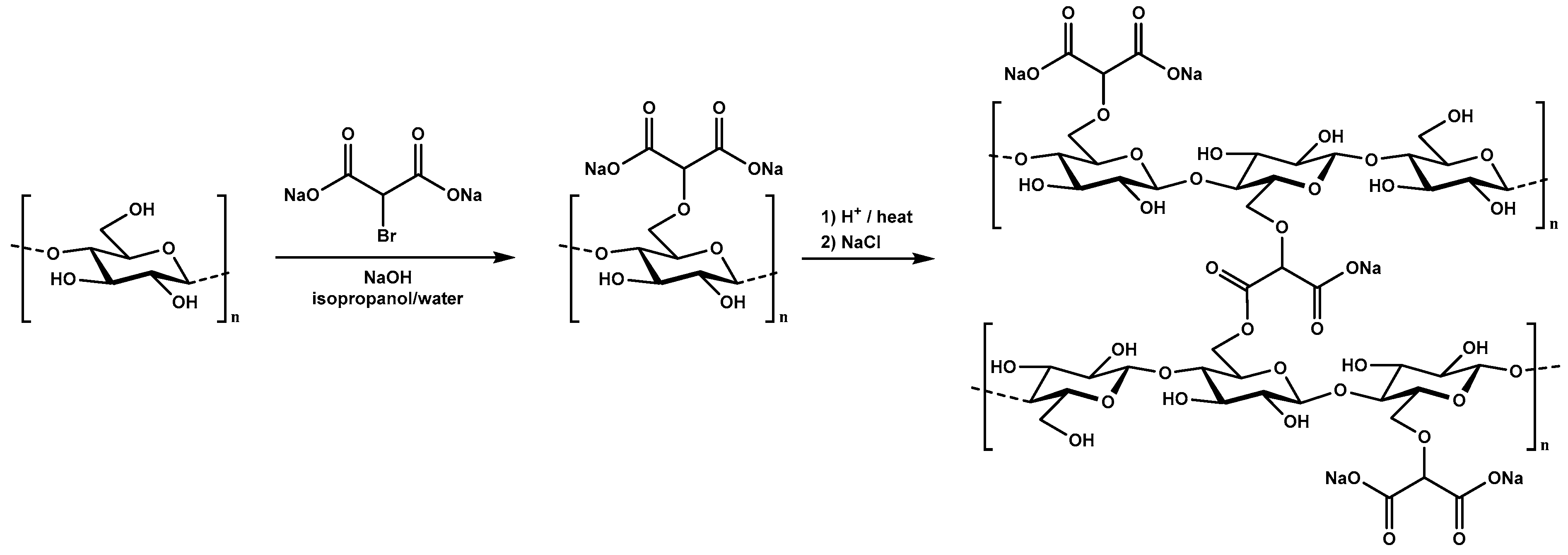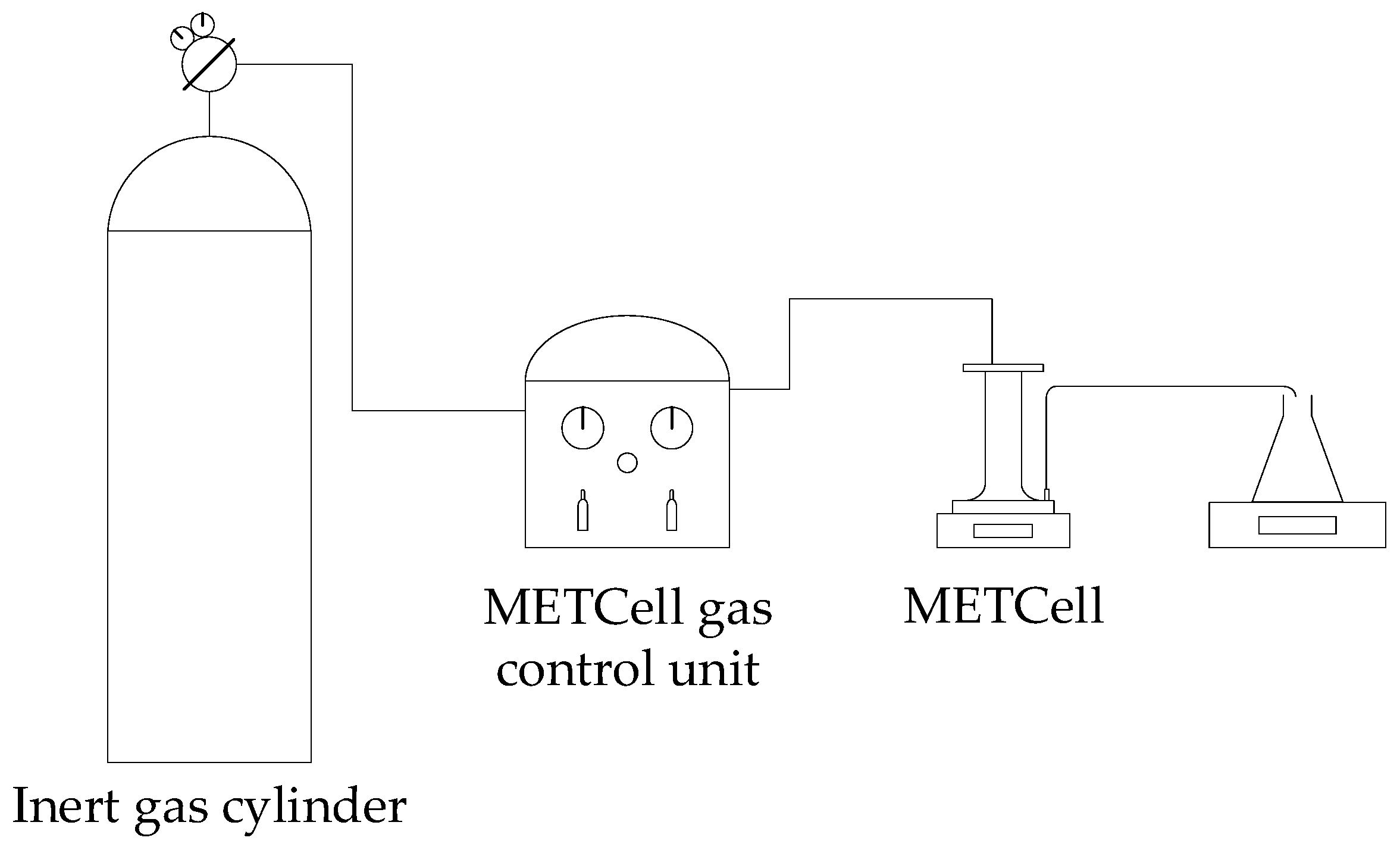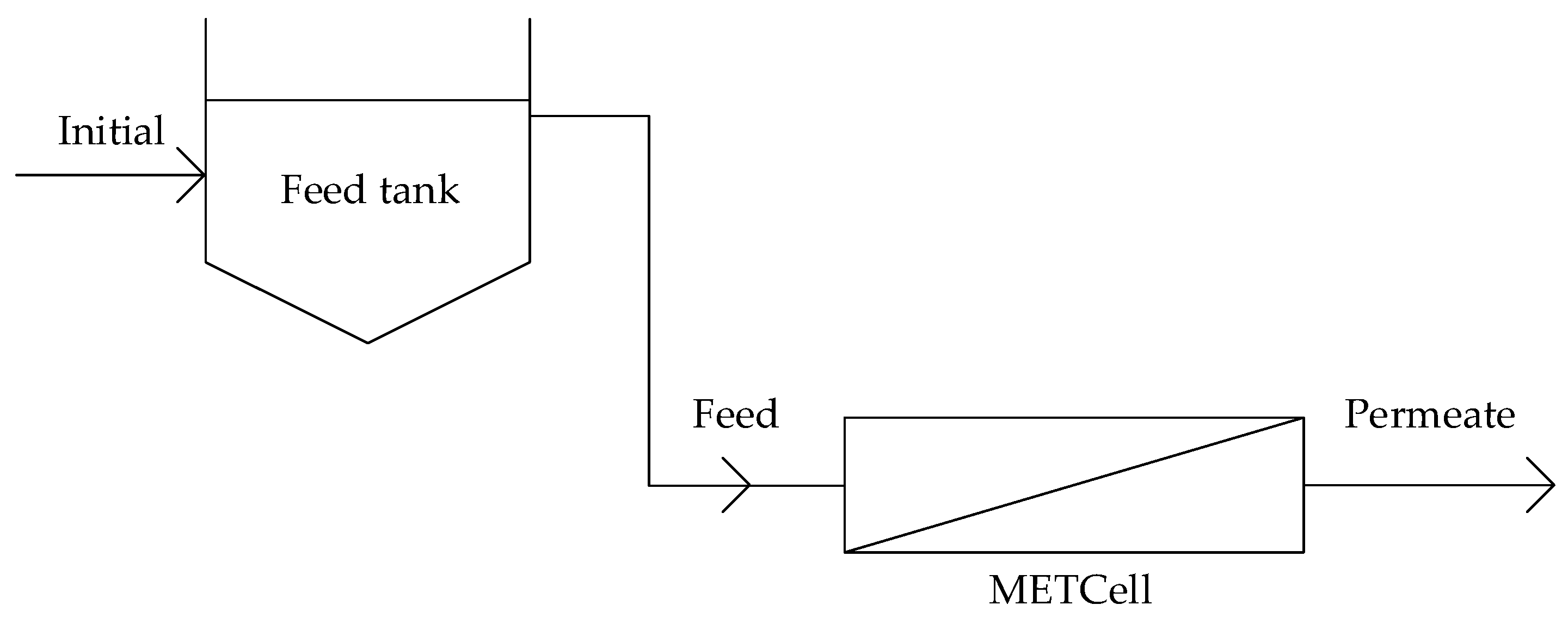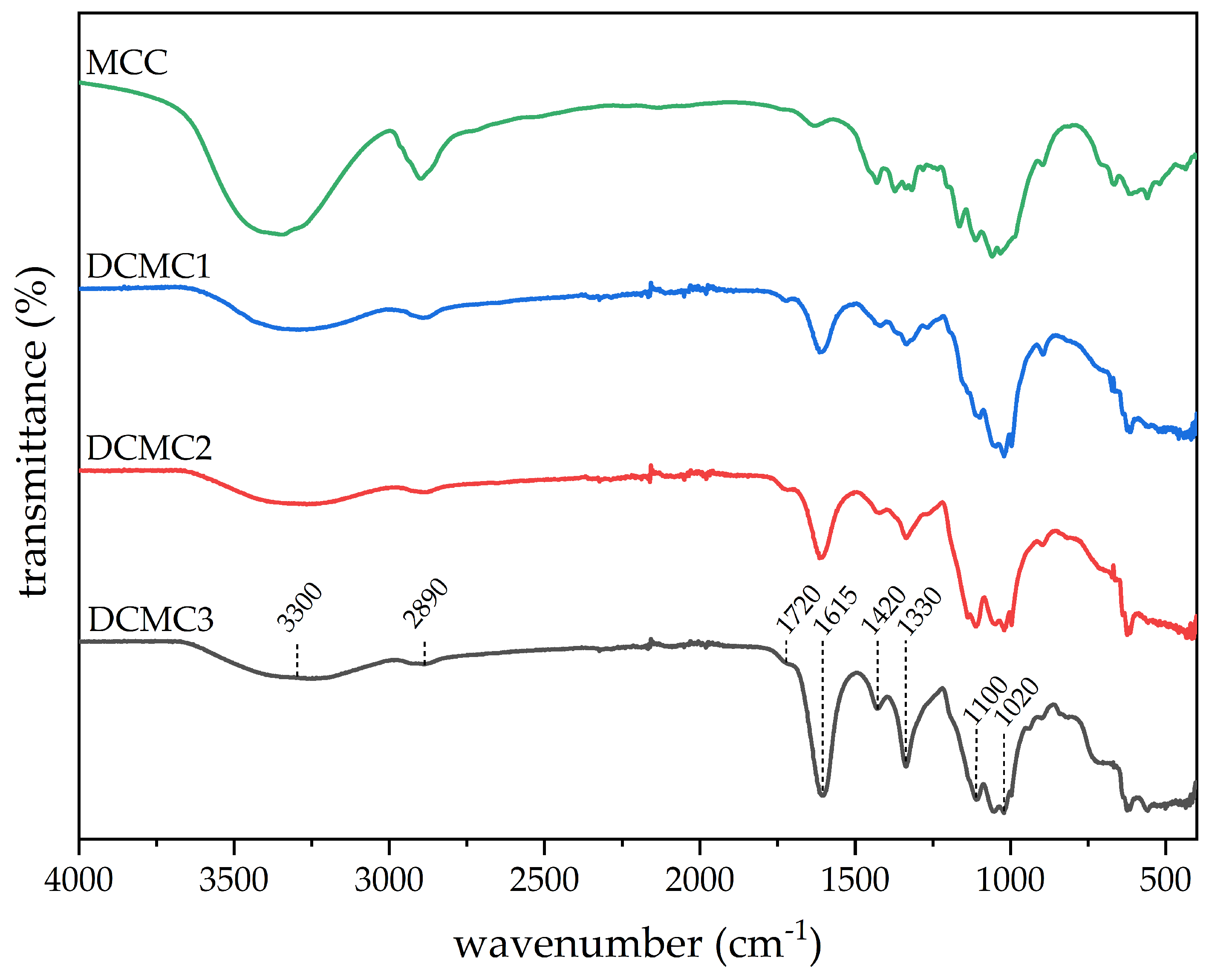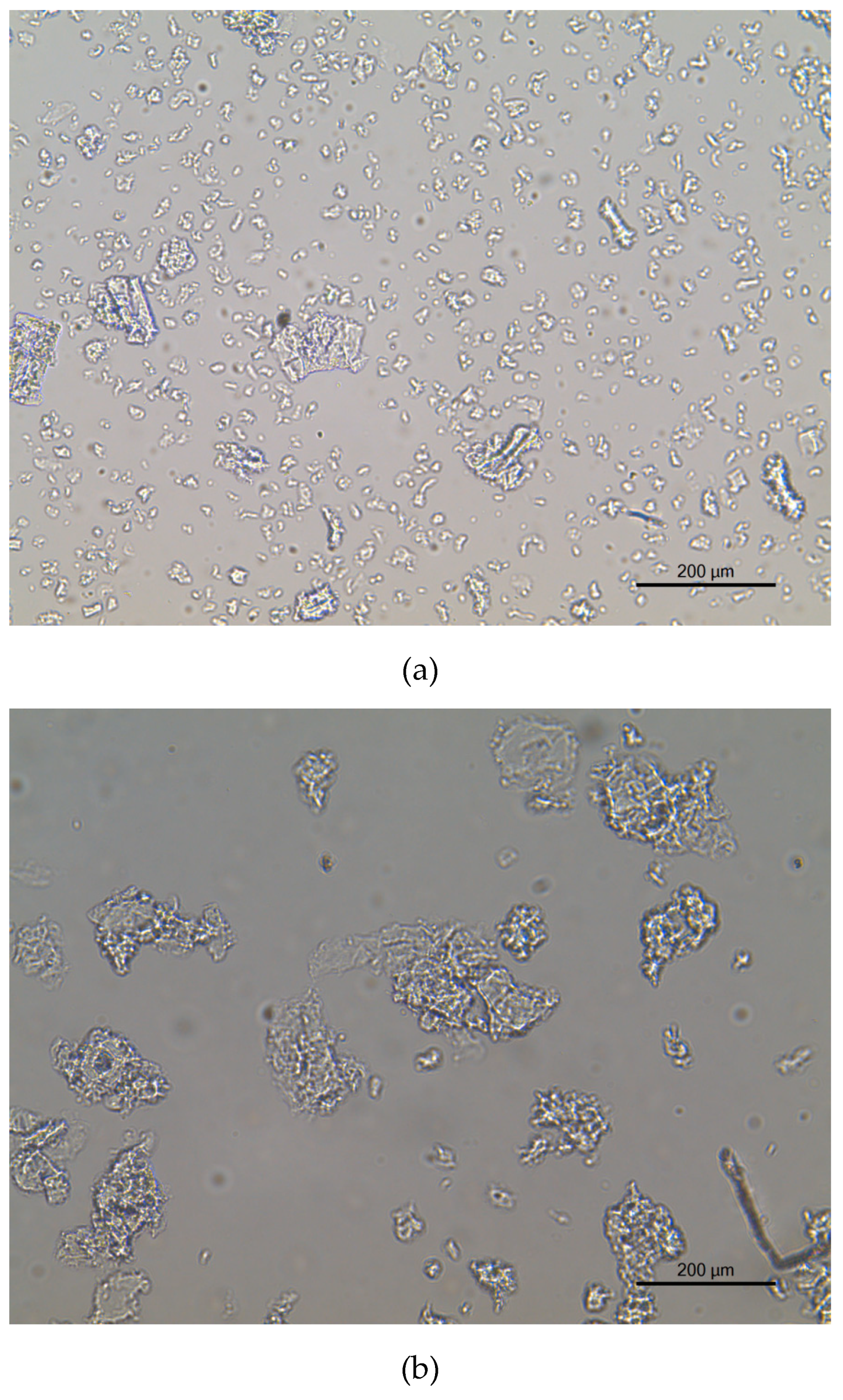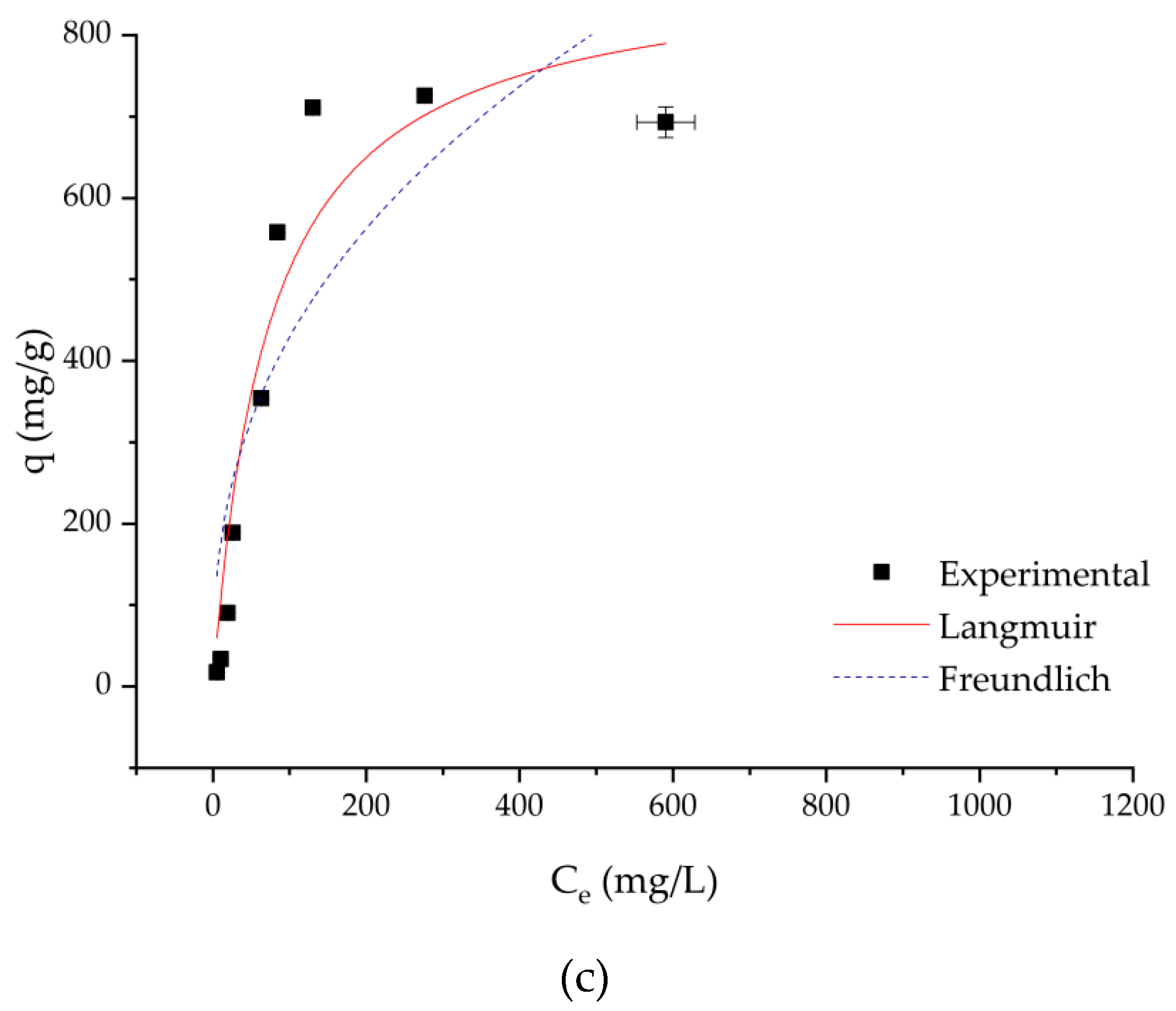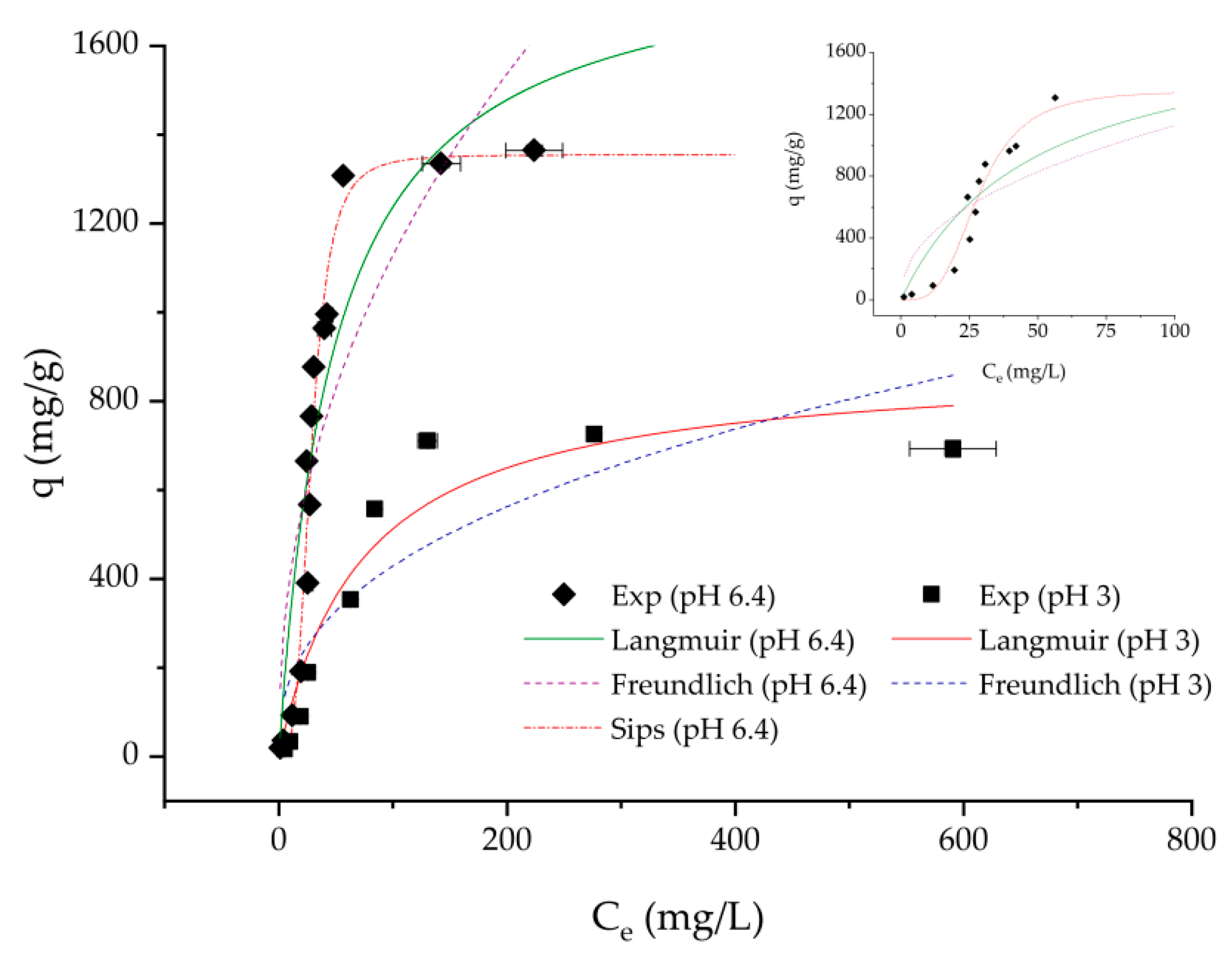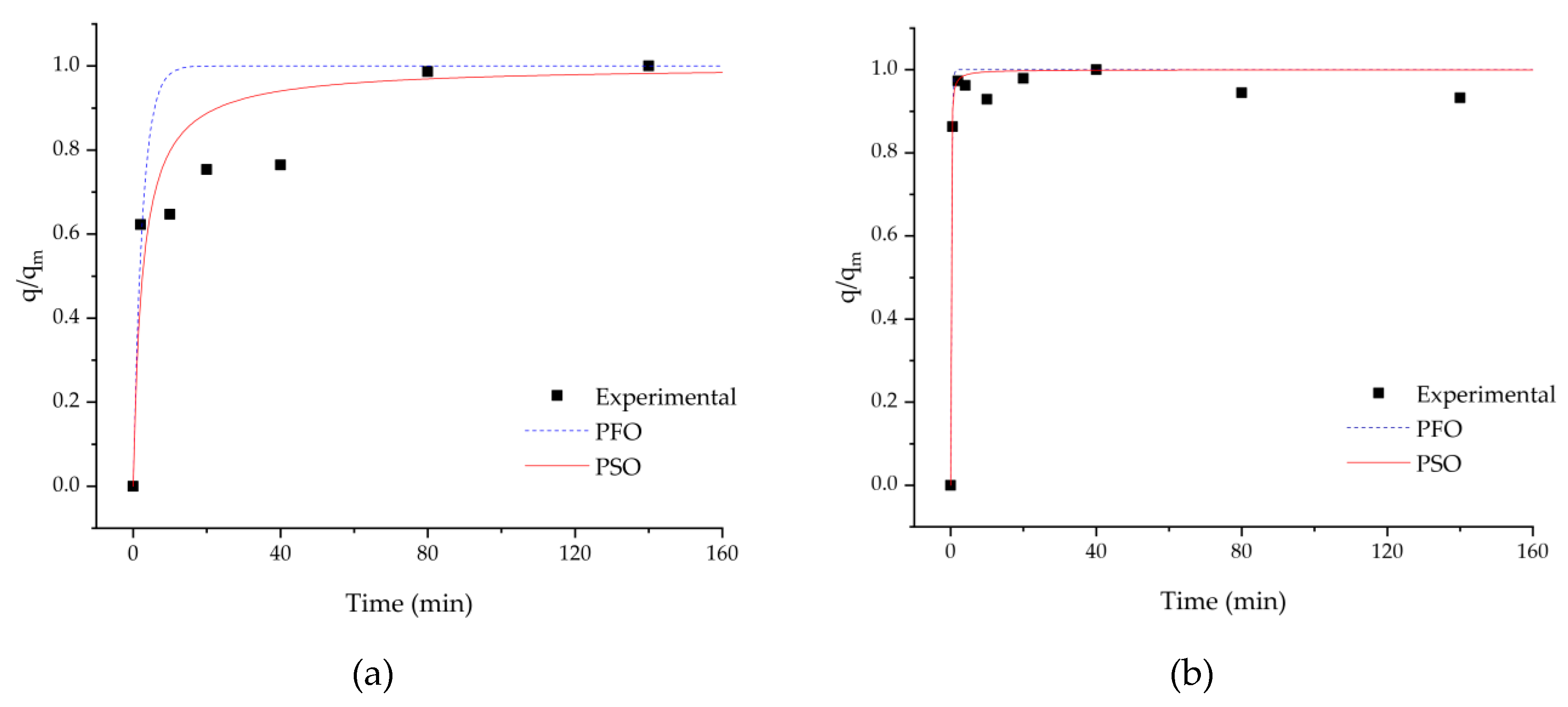1. Introduction
Dyes and pigments are used in several chemical industries, such as pharmaceutical and textile. These industrial processes require large volumes of water and are responsible for the annual release of up to 150,000 tons of dyes into wastewaters [
1]. The presence of dyes in wastewaters is easily recognized by human eye, due to a change of color, and may have dire effects on aquatic life and compromising photosynthetic activity of certain aquatic species [
2]. Moreover, these pollutants are generally resistant to biodegradation because of their complex aromatic structures [
2]. Methylene blue is a common representative of cationic dyes [
3]. It is typically used in the textile industry, for dying cotton and silk [
4]. Numerous reports are available in the literature concerning the removal of this specific dye. Environmental awareness and regulatory measures contribute to a growing interest on cheaper and more effective techniques for the treatment of wastewaters containing dyes [
1,
3,
4].
Many techniques have been tested for dye removal and adsorption is considered the most efficient process due to its low cost, simplicity, and lack of formation of harmful byproducts [
1,
4,
5]. Ion exchange is also commonly used in wastewater treatment [
6,
7]. Activated carbons are used as adsorbents due to their efficiency in dye removal. However, their high production cost urges the research on alternative economical and renewable adsorbents [
4,
8,
9].
Cellulose is the most abundant organic material in nature. It is biodegradable and renewable. Cellulose-based materials are commonly used in various applications, namely as adsorbents in wastewater treatment [
10,
11,
12]. The development of new cellulose-based polymers is motivated by the demand of low-cost and environmentally friendly materials [
10].
Dicarboxymethyl cellulose (DCMC) is prepared by reaction of sodium 2-bromomalonate with cellulose [
13,
14]. Malonic acid has pKa values of approximately 2.85 and 5.70, which the cellulose bond should not greatly influence, resulting in mainly deprotonated acid groups for pH greater than 3 [
15]. For this reason, DCMC can perform ion exchange at low pH [
16]. The polymer works as an anionic polyelectrolyte, suitable for the removal of positively charged synthetic dyes due to its active functional groups, such as hydroxyl and carboxyl [
16,
17].
In this work, the potential of cross-linked dicarboxymethyl cellulose for removal of methylene blue as a cationic dye model was investigated. The synthesized polymers were characterized using inductively coupled plasma atomic emission spectrometry (ICP-AES) and Fourier-transform infrared spectroscopy (FTIR). Influence of parameters, such as solution pH and number of carboxylate groups per gram of polymer, were studied. Adsorption equilibrium and kinetic studies were performed. Equilibrium adsorption isotherms are essential in understanding the interactions between adsorbent and adsorbate, providing information on surface properties and adsorption capacities [
5,
8,
18,
19,
20]. Langmuir isotherm assumes that adsorption occurs without lateral interactions between adsorbed molecules, producing homogeneous binding sites and a monolayer coverage of the outer surface of the adsorbent [
8,
21,
22]. Freundlich isotherm states that adsorption occurs on a heterogeneous surface, where binding strength decreases with increasing occupation [
8,
21]. Sips isotherm is a combination of the Langmuir and Freundlich isotherm models [
23,
24]. Kinetic studies give better understanding of the adsorption process, namely adsorbent behavior in the presence of distinct adsorbates [
3,
19,
25]. Lagergren first described adsorption kinetics of liquid-solid systems based on solid capacity [
26,
27]. Lagergren’s pseudo first-order (PFO) equation is based on the assumption of physisorption process [
28]. The PFO model assumes that the sorption rate decreases linearly as the sorption capacity increases [
12]. The pseudo second-order (PSO) model is similar to PFO, but it suggests a chemisorption process [
28,
29].
Membrane filtration is increasingly used in water treatment processes [
30,
31]. However, disadvantages such as membrane fouling often contribute to reduced process performance over time. To minimize such limitations, possible membrane-solute interactions should be avoided [
30]. Therefore, the use of adsorption coupled with membrane filtration has great potential in wastewater treatment, since it can prevent direct solute(s) contact with the membrane, thus minimizing its fouling [
31,
32]. In this work, adsorption was coupled with filtration in a MET
®Cell Dead-End system using ultrafiltration membranes, such as Microdyn Nadir UV150 and UC500. Adsorbent and membrane reusability studies were also performed.
2. Materials and Methods
2.1. Materials
Air-dry cellulose (MN 400 Avicel) was obtained from Macherey-Nagel. Sodium bromomalonate was previously synthesized by LAQV-REQUIMTE with bromine and malonic acid. A standard citrate buffer solution (25 mM, pH = 3) was prepared with sodium citrate dihydrate (MW = 294 g/mol) and citric acid monohydrate (MW = 210 g/mol) to be used as a buffer. Deionized water without any buffer was used to prepare methylene blue solutions with a pH = 6.4. Separate stock solutions with a concentration of 2 and 3 g/L were prepared by dissolving the required amount of methylene blue in deionized water or citrate buffer. The solutions were diluted with deionized water or citrate buffer to achieve concentration and pH values needed for the experiment. Other chemicals and solvents were laboratory grade and used without further purification.
2.2. Synthesis of Dicarboxymethyl Cellulose
Cross-linked dicarboxymethyl cellulose (DCMC) was synthesized specifically for this work. Three different polymers were prepared differing in the amount of sodium 2-bromomalonate (BMA) added. To produce polymers with varying number of carboxylate groups, 1, 2, or 3 molar equivalents of BMA were added per anhydroglucose units (AGU), resulting in DCMC 1, DCMC 2, or DCMC 3 respectively. DCMC was synthesized following the procedure described by Ferreira et al. [
13,
14].
Figure 1 presents the schematic representation of the synthesis of dicarboxymethyl cellulose.
A total of 5 g of air-dry cellulose and 175 mL isopropanol were stirred vigorously and 5.5 mL of water with 3.7 g of NaOH was slowly added to the mixture for 10 min at room temperature. The mixture was magnetically stirred for 1 h and the appropriate quantity of sodium 2-bromomalonate in 18 mL of water was added. After complete dispersion, the mixture was placed on a water bath at 60 °C for 3 h with vigorous stirring. After this time, the reaction mixture was filtrated, and the solid suspended in 70% (
v/
v) methanol and neutralized with acetic acid. Aqueous and pure methanol were used for further purification of the product. Finally, the product dried under vacuum at room temperature. The latter was protonated dispersing the powdered product in 20% sulfuric acid solution for 1 h. The product was decanted, and the precipitate washed with distilled water until neutral pH. After drying, the protonated polymer was heated at 100 °C for 1 h promoting its cross-linking by esterification (formation of ester bonds between the carboxylic acid of the malonate group and the hydroxyl group of adjacent cellulose chains). The resulting cross-linked polymer was washed with 1 M NaCl until neutral pH followed by washing with distilled water to remove remaining NaCl. The sodium salt of the cross-linked polymer was isolated by filtration and dried under vacuum yielding a white powder.
Table 1 shows the appropriate quantities of each reagent for the synthesis of dicarboxymethyl cellulose in these conditions.
2.3. Characterization of Dicarboxymethyl Cellulose
Characterization methods were performed to determine the influence of stoichiometry on chemical structure. Differences in sodium content were assessed by ICP-AES. For it, sodium dicarboxymethyl cellulose was first purified by dialysis against deionized water. Dry dialyzed samples were hydrolyzed for ICP analysis by adding 500 µL nitric acid to a known mass of polymer (approximately 1.0 mg). Then, they were incubated at 70 °C for 1 h and analyzed on a Horiba Jobin-Yvon Ultima model equipped with a 40.68 MHz RF generator, a Czerny–Turner monochromator with 1.00 m (sequential), and an autosampler AS500 (Horiba, Kyoto, Japan). The resulting percentage of sodium is equivalent to the number of carboxylate functional groups able to perform the desired cation exchange. Percentage of sodium in each sample is defined as the sodium to polymer mass ratio (
w/
w). The number of carboxylate groups per gram of polymer (CG) was calculated by Equation (1).
where the term “23” represents the molecular mass of sodium.
FTIR spectra of the samples were recorded on a Perkin-Elmer FT-IR Spectrometer Spectrum Two (Waltham, MA, USA), equipped with an attenuated total reflection (ATR) cell, in the range of 4000–400 cm−1. The pore size distribution was determined by nitrogen adsorption-desorption experiments at 196 °C (77 K), using a Micromeritics ASAP 2010 instrument (Micromeritics, Norcross, GA, USA). The Brunauer–Emmett–Teller (BET) method was used to calculate specific surface area. Morphology and size distribution of dicarboxymethyl cellulose were analyzed by optical microscopy with a Nikon Eclipse ci (Tokyo, Japan). The images were processed with ImageJ software (National Institutes of Health, Bethesda, MD, USA).
2.4. Adsorption Experiments of Methylene Blue
The influence of number of carboxylate groups per gram of polymer was studied at pH = 3. The process was also studied at pH = 6.4 (DI water) for the polymer with higher adsorption capacity at pH = 3. Two mL of methylene blue solutions with concentrations between 40 and 3000 mg/L were added to 4 mg of polymer and kept in a water bath for 48 h and at room temperature (25 °C). A Spectronic Helios Alpha spectrometer (Thermo Electron, Waltham, MA, USA) was used to determine methylene blue concentrations at 664 nm, by comparison with a calibration curve in the range of 0–4 mg/L prepared with methylene blue and deionized water or citrate buffer. The experiment was performed in triplicate and mean values are presented. The adsorption capacity is calculated by Equation (2).
where
q (mg/g) is adsorption capacity;
C0 and
Ce (mg/L) are the initial and equilibrium concentrations of methylene blue in the solution, respectively;
V (L) is solution volume and
m (g) is adsorbent mass.
2.5. Modelling of Adsorption Isotherms
Adsorption isotherms describe interactions between adsorbate and adsorbent [
22]. In the present work, Langmuir, Freundlich, and Sips models were applied and compared for rationalization of the obtained experimental data for equilibrium adsorption of methylene blue onto dicarboxymethyl cellulose.
The Langmuir isotherm is expressed by Equation (3) [
8,
21].
where
qm (mg/g) is the maximum adsorption capacity,
Ce (mg/L) is equilibrium concentration, and
Kd (L/g) is the Langmuir adsorption equilibrium constant, representing the affinity between adsorbate and binding sites.
The Freundlich mathematical model is expressed by Equation (4) [
8,
21].
where
K (L/mg) is the Freundlich constant, which relates to adsorption capacity,
Ce (mg/L) is equilibrium concentration and
n is the heterogeneity factor. Larger values of
n indicate stronger adsorbate-adsorbent interaction and it is generally stated that values of
n in the range of 1–10 are indicative for favorable adsorption [
26].
The Sips equation is given by Equation (5) [
23,
24,
29,
33,
34].
where
qm (mg/g) is maximum adsorption capacity,
Ks (mg/L)
−1/ns is the Sips equilibrium constant,
Ce (mg/L) is equilibrium concentration, and 1/
ns is the heterogeneity factor.
2.6. Kinetic Adsorption Experiments and Modelling
Experiments were performed with 2 mL methylene blue solutions with concentration of 4 mg/L and 4 mg of DCMC, at pH = 3.0 and 6.4, respectively. Pseudo first-order and pseudo second-order nonlinear kinetic models were used to fit the experimental data.
Pseudo first-order model is expressed by Equation (6) [
25,
35].
where
qm (mg/g) is maximum adsorption capacity,
K1 (min
−1) is the rate constant, and
t (min) is time.
The Pseudo second-order model follows Equation (7) [
25,
35].
where
qm (mg/g) is maximum adsorption capacity,
K2 (mg g
−1 min
−1) is the rate constant, and
t (min) is time.
2.7. Adsorption Coupled with Filtration
Adsorption coupled with filtration experiments were performed using a MET
®Cell Dead-End filtration system (Evonik Membrane Extraction Technology Ltd, London, UK) with a porous membrane disk with 8.1 cm of diameter and active filtration area of 51.5 cm
2 under constant pressure mode. The transmembrane pressure was monitored by a pressure transducer connected at the cell inlet. The permeate flux was determined by measuring the permeate weight with an electronic balance, connected to a computer for continuous data acquisition. All tests in this study were performed with no fluid agitation.
Figure 2 presents a schematic diagram of the experimental setup for membrane filtration.
Preliminary filtration experiments using commercial membranes of PVDF and regenerated cellulose (Microdyn Nadir UV150 and UC500, respectively) were performed. A total of 200 mL of a 4 mg/L methylene blue aqueous solution were added to the system. The filtration process was conducted at room temperature without agitation. An ultrafiltration membrane (UV150 or UC500) with a molecular weight of 150 or 500 kDa, respectively, was placed at the bottom of the MET®Cell and supported by a porous stainless-steel disk. The system was operated under argon pressure of 5 bar in order to permeate the liquid through the membrane. Permeate samples were collected and analyzed spectrophotometrically to determine methylene blue concentrations.
Adsorption coupled with filtration experiments were performed by adding 400 mg of DCMC 3 to 200 mL of a 4 mg/L methylene blue aqueous solution. The adsorption process was conducted at room temperature. After 30 min, the mixture was decanted and added to the MET
®Cell system. The ultrafiltration membranes (UV150 or UC500) were used in these experiments as described previously.
Figure 3 presents a schematic diagram for the adsorption coupled with filtration treatment.
Reusability studies were performed on the polymer and on the used membranes using deionized water and 1 M NaCl aqueous solution as eluent agent. After adsorption, the polymer was washed with deionized water and decanted. The membranes were then air dried at room temperature. Both materials were immersed in deionized water and in the NaCl solution for 3 h for desorption of dye molecules and the solutions were analyzed spectrophotometrically to determine methylene blue concentrations.
4. Conclusions
In this study, cross-linked dicarboxymethyl cellulose prepared from air-dried cellulose was used for the adsorption of methylene blue from aqueous solutions. Adjusting the number of sodium 2-bromomalonate (BMA) equivalents in the synthesis increased functionalization. FTIR and ICP provided information on the effect of BMA equivalents in the chemical modification of the polymer. As expected, increasing BMA molar equivalents increases the number of carboxylate groups per gram of polymer (CG). Experimental results showed that methylene blue adsorption was dependent on adsorbent surface characteristics, which are dependent on the solution pH. At an acidic pH, the Langmuir isotherm model adjusted the experimental data better, suggesting monolayer adsorption on a homogenous adsorbent surface. The maximum dye uptake at these conditions was 887.6 mg/g. At pH = 6.4, experimental data fitted with the Sips isotherm model with calculated maximum adsorption capacities very close to experimental values (1354.6 and 1365.5 mg/g, respectively). Significant dye uptakes suggest dicarboxymethyl cellulose can be used as an alternative to commercial adsorbents. Kinetics studies revealed experiments were well described by the pseudo second-order kinetic model which is associated with chemisorption processes. Filtration experiments using ultrafiltration membranes proved successful in removing methylene blue. Filtration with Microdyn Nadin UV150 and UC500 removed close to 90% of this cationic dye. Even though the membranes pore size was much larger than that of methylene blue, it was not permeated. Dye adsorption coupled with filtration was slightly more efficient in the removal of methylene blue (≈95%), but the process was much slower. Reusability studies showed that DCMC can be reused, whereas the membranes did not desorb the cationic dye. The reusability of the polymer can clearly contribute to a more sustainable and cost-effective process. Future work should address the use of DCMC in the treatment of real wastewater including scale-up experiments allowing a detailed cost-benefit analysis to assess commercial feasibility of the treatment proposed.
